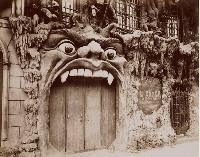Cave
From The Art and Popular Culture Encyclopedia

|
"And now, I said, let me show in a figure how far our nature is enlightened or unenlightened:—Behold! human beings living in a underground den, which has a mouth open towards the light and reaching all along the den; here they have been from their childhood, and have their legs and necks chained so that they cannot move, and can only see before them, being prevented by the chains from turning round their heads. Above and behind them a fire is blazing at a distance, and between the fire and the prisoners there is a raised way; and you will see, if you look, a low wall built along the way, like the screen which marionette players have in front of them, over which they show the puppets."--Allegory of the cave, Plato, Jowett translation |
|
Related e |
|
Featured: |
Throughout history, primitive peoples have made use of caves for shelter, burial, or as religious sites. Since items placed in caves are protected from the climate and scavenging animals, this means caves are an archaeological treasure house for learning about these people. Cave paintings are of particular interest. One example is the Great Cave of Niah, in Malaysia, which contains evidence of human habitation dating back 40,000 years.
In the animal kingdom, caves offer shelter, including uses such as maternity dens.
In Germany some experts found signs of cannibalism in the caves at the Hönne.
Caves are also important for geological research because they can reveal details of past climatic conditions in speleothems and sedimentary rock layers.
See also

